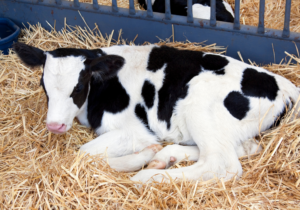It is misguided to think that calves will not build up enough immunity if calf housing is “too clean”. Like with most mammals, immunity is built up over time and does not excuse filthy pens and unforgiving environments.
As with most new-born animals, there is a strong relation between hygiene and performance and health. This is the same with new-born calves and is heightened by the fact that calves require passive immunity from colostrum. There are two fundamental areas of hygiene; 1) the hygiene of environment, the external place where the calf is located and 2) hygiene of ingested liquid and feed which equates to colostrum and milk feeds.

Within the cow, the calf is in a sterile and clean environment. Once calved, this all changes, the calf is exposed, having to look after itself in addition to looking for feed. At this stage it is important to have clean calving pen. If a calf is born in a mucky and dirty pen there is an increased risk of poor colostrum intake and antibody uptake due to a heightened level of bacteria. Calves are likely to ingest the bacteria which will stimulate the closure of the epithelial lining before the colostrum is even offered.
The second point with hygiene is the cleanliness of the liquid feed ingested by the calf. This starts with how the colostrum is harvested. The cow’s teat must be clean before taking the colostrum off and it is critical can the container and equipment used to do this is sterile and is cleaned effectively and after every cow. Many units pasteurise colostrum which is beneficial to reduce the bacterial loading of the colostrum, however, will not reduce Johnes!
It is important when storing and freezing colostrum it is done so in a way which reduces the risk of increased bacterial loading. Key points to consider when doing this is:
- Reducing the temperature quickly and freeze (within 48 hours)
- Clean storage containers, bags and location
- Clearly identifying the colostrum
It is important when defrosting the colostrum, again it should be done so to keep bacterial loading to a minimum. We understand that there will always be some bacteria but by keeping this to a minimum and management to do so will help give the best start you calves. Defrosting colostrum should be done at a temperature under 60 degrees to minimise deaminating the antibodies and should be administered to the calf using clean equipment!
For more advice and information, please get in touch on 0800 756 2787 or speak to your local NWF Sales Specialist.

